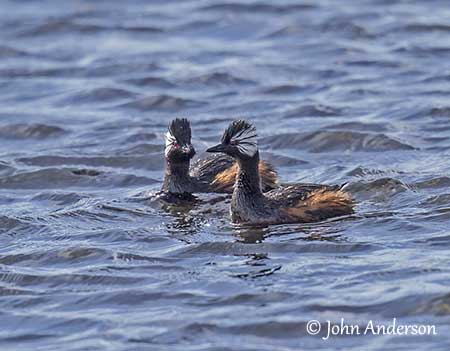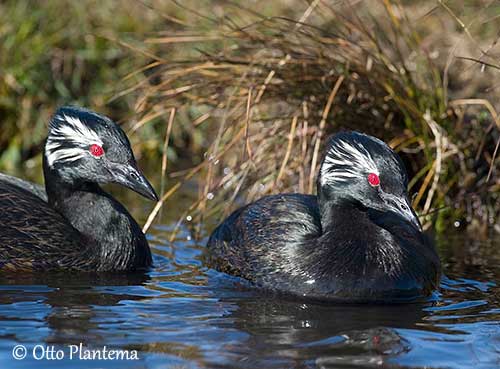
Fr: Grèbe de Rolland
Ang: White-tufted Grebe
All: Rollandtaucher
Esp: Zampullín Pimpollo
Ita: Svasso ciuffibianchi
Nd: Witwangfuut
Sd: vittofsad dopping
Photographers:
Roger Ahlman
Pbase Galleries Peru and Ecuador
John Anderson
John Anderson Photo Galleries
Otto Plantema
Trips around the world
Philippe et Aline Wolfer
OISEAUX D'ARGENTINE
Text by Nicole Bouglouan
Sources:
HANDBOOK OF THE BIRDS OF THE WORLD vol 1 by Josep del Hoyo-Andrew Elliot-Jordi Sargatal - Lynx Edicions - ISBN: 8487334105
BIRDS OF PERU by Thomas S. Schulenberg, Douglas F. Stotz, Daniel F. Lane, John P. O’Neill, Theodore A. Parker III – Princeton University Press 2007– ISBN: 978-0-691-13023-1
The Cornell Lab of Ornithology - Birds of the World
Birds of the Falklands Islands
Birding Patagonia – Adventure expeditions
Arthur Grosset's Birds (Arthur Grosset)
Wikipedia, the free encyclopaedia
White-tufted Grebe
Rollandia rolland
Podicipediformes Order – Podicipedidae Family
INTRODUCTION:
The White-tufted Grebe is found in southern South America, from C Peru to Cape Horn and Falkland Islands.
It frequents a variety of wetland habitats, mainly shallow water with aquatic vegetation. It feeds primarily on fish, but it also takes arthropods and other invertebrates. It feeds by diving from the surface. The nest is a floating structure anchored to aquatic plants.
The White-tufted Grebe is widespread throughout its large range. It is affected by water pollution and fluctuating water levels in some regions. But currently, the species is not globally threatened.
DESCRIPTION OF THE BIRD:
Biometrics:
Length: 26-30 cm
The White-tufted Grebe of nominate race in breeding plumage has blackish upperparts and neck to breast, with brownish tinge and some greenish gloss. On the upperwing, the coverts may appear browner. The flight-feathers are dull brownish with whitish markings on secondaries.

On the underparts, body sides and flanks are brownish-black with some chestnut tinge. Breast and belly are chestnut with some pale grey markings. The undertail-coverts are white, whereas rear flanks and vent are bright rufous. On the underwing, the coverts are white.
The head is brownish-black. The feathers of both nape and head sides are longer and form a tuft. We can see a conspicuous white, triangle-shaped patch on sides of head, extending from above and behind the eye to sides of nape. Some black lines are visible among the white feathers.
The bill is blackish to greyish-black. The eyes are red. Legs and feet are dark grey to olivaceous.
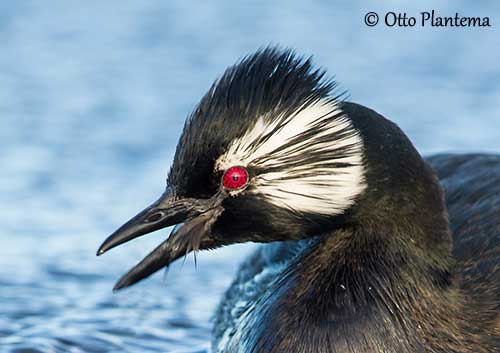
The non-breeding adult is duller overall, generally paler and browner. Crown and upperparts are very dark. Head sides to chin, throat and upper foreneck are whitish, and there are some narrow dark streaks on head sides. Rest of foreneck and neck sides are washed rufous-buff. The underparts are tinged cinnamon-buff, mainly visible on flanks.
Male and female are similar.
The juvenile shows irregular blackish stripes on the face and the eyes are duller. It resembles overall to the non-breeding adult, but with shorter head feathers.
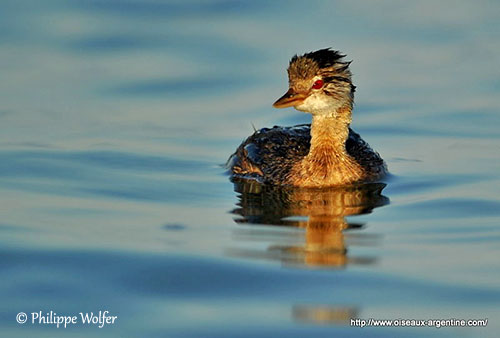
R.r. chilensis
Non-breeding adult
SUBSPECIES AND RANGE:
The White-tufted Grebe has three subspecies.
R.r. morrisoni is found in C Peru.
This race is smaller overall, with duller rufous underparts than nominate.
R.r. chilensis is found in NW Peru and SE Brazil, S to Cape Horn. It winters on the coast, and some other birds move N to Paraguay and S Brazil.
This race is similar to the previous, but even smaller (half of nominate). The bill is smaller too.
R.r. rolland (described above) is found on Falkland Islands.
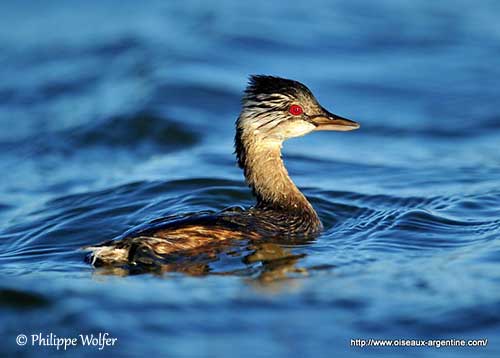
HABITAT:
The White-tufted Grebe frequents a large variety of wetland habitats and all types of water bodies including lakes, ponds, rivers and slow-flowing streams. It can be seen sometimes on seashores.
It favours the shallow water with aquatic vegetation, but also more open water areas. On more open water bodies, it occurs along the thick vegetation of the shores.
The species is visible in puna areas between 3,500 and 4,500 metres of elevation.
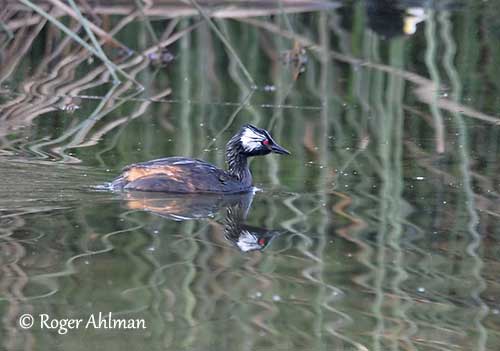
CALLS AND SONGS: SOUNDS BY XENO-CANTO
The White-tufted Grebe gives a weak, nasal, slightly melancholic scream. Other vocalisations include whistles, cracking and growling sounds. The alarm call is “jrrrh”.
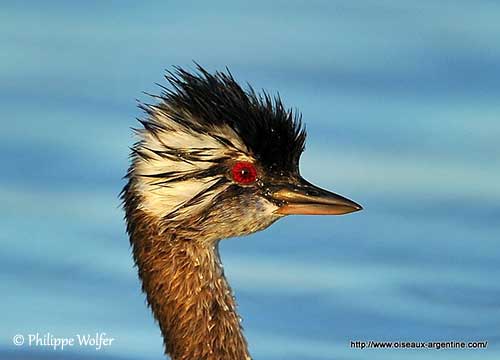
BEHAVIOUR IN THE WILD:
The White-tufted Grebe feeds on small fish which is the main part of the diet. However, it also consumes various arthropods, beetles, hemipteran, insect larvae, molluscs and crustaceans, and also some plants.
It usually forages from the surface with the head submerged. It also dives during 18-20 seconds after a forwards leap.
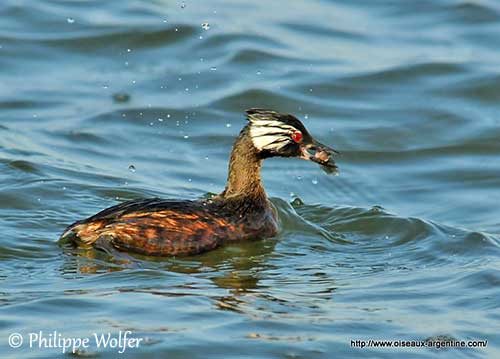
The White-tufted Grebe nests in a floating structure anchored to aquatic plants.
From an observation on Falkland Islands, the copulation occurs on land. Both partners hopped ashore and walked up to two metres, before the female solicits the male for copulation.
This species is usually solitary and territorial, but it may also form colonies, and some cases of co-operative breeding have been observed, with the young of the previous year helping to raise the last brood.
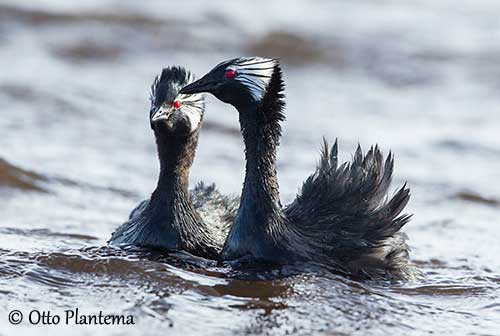
The White-tufted Grebe of southern populations usually performs some movements after breeding to the nearby coasts where they spend the winter.
Grebes rarely fly in the daytime. It threatened the White-tufted Grebe dives swiftly or patters over water while performing rapid wingbeats.
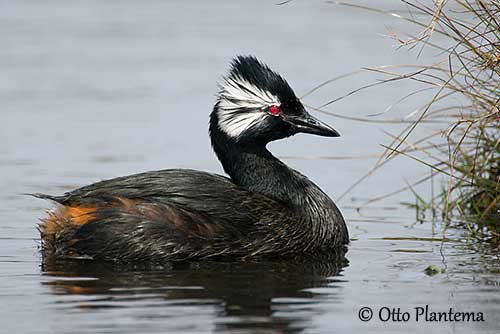
REPRODUCTION OF THIS SPECIES:
The breeding season takes place in September/October, but often two months later at high elevations.
In N of the range, it may occur all year-round, whereas in Falkland Islands, the laying is often reported between October and January, but most laying occurs in October.
The White-tufted Grebe builds a floating platform made with aquatic vegetation. The nest is anchored to adjacent plants.
In Falkland Islands, the nest is usually built in clump of grass (Poa flabellata) on lake shore, but other nests are located under the overhanging banks of ponds or in small ditches connected to larger ponds, and also in rushes (Juncaceae) in the shallows of a pond. These nests are well hidden among the vegetation, but the grebes can only escape forwards.
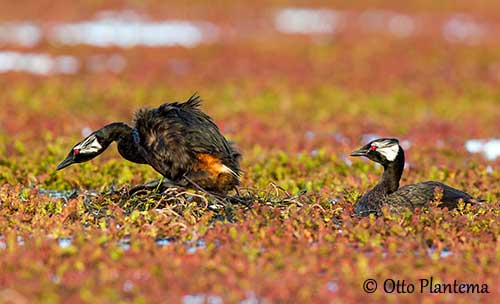
The female usually lays two eggs (1-3 and occasionally up to six). The eggs are whitish first, but they quickly become yellowish-brown as the incubation is progressing. At hatching, the chicks have blackish and brown stripes and spots on head and neck, with some whitish lines. The upperparts are dark brownish-grey with faint brown stripes, and the underparts are paler.
The duration of both incubation and fledging periods is currently unknown.
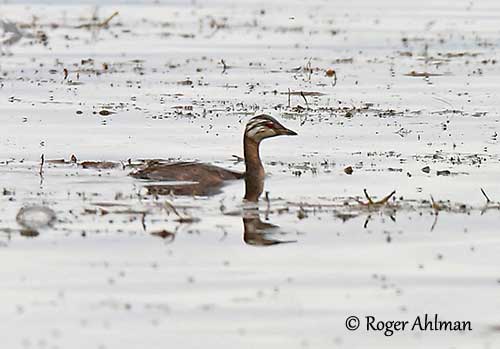
PROTECTION / THREATS / STATUS:
The White-tufted Grebe is usually widespread and relatively common, and even abundant throughout its large range.
It may be affected by water pollution and fluctuating water levels caused by human activities.
The Falkland Islands population was estimated at 750/1,500 pairs between 1983 and 1993. The numbers of the race “morrisoni” are estimated at 1,000/4,000 individuals. The race “chilensis” needs more recent counts, but about 12,000 are estimated in Argentina.
The global population is decreasing, but the species is not considered globally endangered.
The White-tufted Grebe is currently evaluated as Least Concern.
